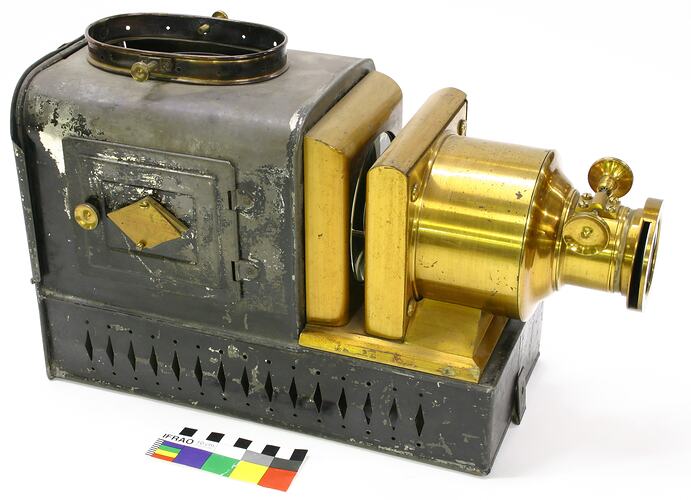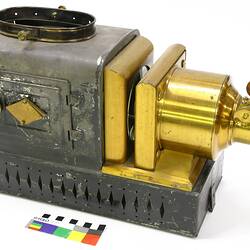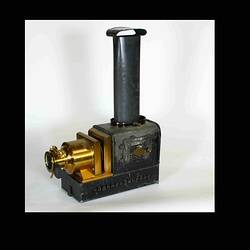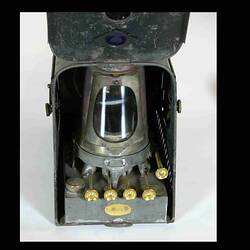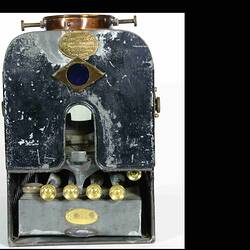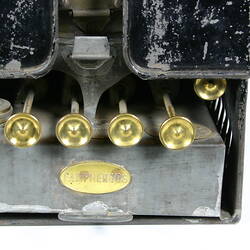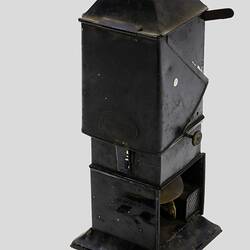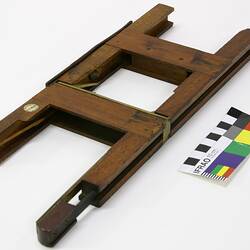Summary
The Pamphengos magic lantern was designed and produced by the optician William Charles Hughes, who first brought out this model in 1880. Its illumination system was fuelled by paraffin and was the first to use a four wick burner.
The illuminant system is separate to the lantern body and slides out, allowing alternative lighting fuels such as limelight, carbon arc or acetylene to be used. A chimney or cowl could be attached to the chimney housing by two screws, depending on the illuminant used. In keeping with the multiple illumination system, the body of the lantern was designed to capture this flexibility. It features access to the illuminant chamber from the back, which was used with paraffin burners, as well as side access doors with blue glass sighting windows, used with the other illuminants.
W.C. Hughes was an optician as well as a designer, manufacturer and retailer of magic lanterns, taking out numerous patents over the years. Prior to operating his business as an optician Hughes had been a showman, giving dramatic readings in theatres, as well as performing songs and magic shows.
While the invention of the magic lantern is generally seen to be in the 17th century, its greatest popularity as an optical projector spans the late 18th Century to the early decades of the 20th Century. It was used both as a means of entertainment and education.
This lantern projector is part of the Francis Collection of pre-cinematic apparatus and ephemera, acquired by the Australian and Victorian Governments in 1975. David Francis was the curator of the National Film and Sound Archive of the British Film Institute as well as being a co-founder of the Museum of the Moving Image in London, which was operational between 1988 and 1999.
Physical Description
A magic lantern consisting of a black metal body and brass projection unit with glass lenses. There is a black metal swivel cover for the front of the projection barrel. The base has decorative recurring pattern of diamond and dot ventilation holes along both long sides. The rectangular side doors and back door contain round blue glass viewing windows within a brass diamond shaped frame. The chimney is not fixed, with the oval chimney housing featuring two screws which allow a chimney or cowl to be attached, depending on the illuminant used. The illuminant is a four wick paraffin burner, with separate control knobs for each wick. There is a separate control for the glass illuminant cover to allow adjustment for air flow. The illuminant tray slides out of the lantern body.
More Information
-
Collection Names
-
Collecting Areas
-
Acquisition Information
Loan & Subsequent Donation from Australian Film Institute (AFI), Mr David Francis, by Nov 1990
-
Manufacturer
W.C. Hughes & Co, Brewster House, 82 Mortimer Road, Kingsland Road, London, England, Great Britain, 1883-1900s
-
Collector
Mr David Francis, London, Middlesex, England, Great Britain, 1990
-
Inscriptions
On front shutter: W.C.HUGHES On oval rear plaque: 'W.C.HUGHES/ OPTICIAN/ BREWSTER HOUSE/ 82. MORTIMER RD/ KINGSLAND RD N/ LONDON.' Three oval inscribed plaques on illuminant: 1. On back wall of fuel resevoir: 'PAMPHENGOS' 2. On back right hand corner floor: 'W.C. HUGHES/PATENT/LONDON' 3. On back center floor: 'W.C. HUGHES/OPTICIAN/BREWSTER HOUSE/82. MORTIMER RD/KINGSLAND RD N/LONDON'
-
Classification
-
Category
-
Discipline
-
Type of item
-
References
Herbert, S. 'Who's Who in Victorian Cinema' [Link 1] Accessed 14 August 2008
[Book] Crompton, Dennis, et al. 1997. Servants of Light: The Book of the Lantern. 94., 1997, 21 Pages
[Book] Robinson, David, et al. 2001. Encyclopaedia of the Magic Lantern., 2001, 141 Pages
-
Keywords
Lantern Projectors, Magic Lanterns, Pre-Cinema Moving Images, Projectors, Innovation & Design
